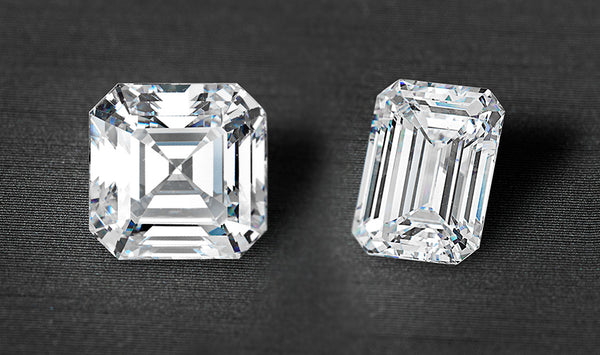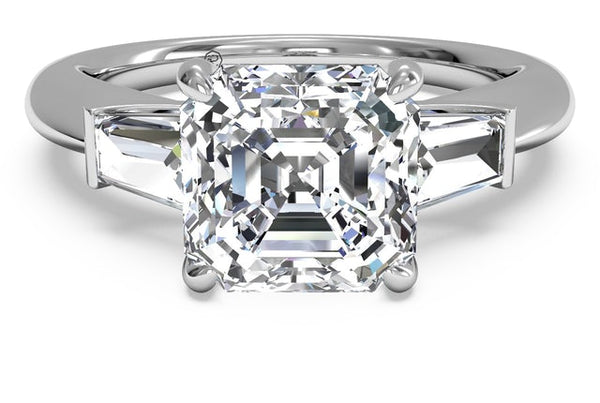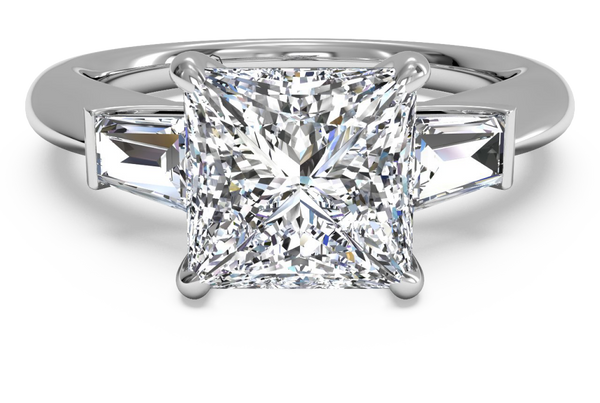What Is a Step Cut Diamond?

In the world of diamond cuts, similar shapes are grouped together into families: brilliant, step cut, mixed, and rose. Every diamond cut family has its own set of unique pros and cons. This means that there is no “one cut fits all” strategy for getting the best diamond–certain shopping tips that are great for one diamond shape won’t be good for another.
A Short Introduction To Step Cut Diamonds
A step cut diamond features eight lines running down the sides to draw the viewer’s attention to the center of the stone. It also has stepped facets running along its length and width in parallel lines, reminiscent of the steps of an Aztec temple or pyramid. The diamond facets tend to be larger than in brilliant cut diamonds and they are arranged to look like steps, hence the name. Step cut diamonds are known for their dazzling “hall of mirrors” effect.
Which Diamond Shapes Are Step Cut Diamonds?
The three diamond shapes in the step cut family are emerald cut, Asscher cut and baguette cut. Asscher and emerald are most commonly used in engagement rings, while baguette diamonds are usually used as accents or in smaller pieces of jewelry.

Emerald
Known for its elegant rectangular shape, an emerald cut diamond has cropped corners, a large table and an elongated pavilion.
Asscher
Prized for the distinctive ‘X’ visible in its table, this square diamond shape has cropped corners and mesmerizing angles.
Baguette
This thin, rectangular diamond has less facets than emerald cuts and Asscher cuts, is used as an accent stone or in fine jewelry.
What Are The Necessary Characteristics of A Step Cut Diamond?
Stepped cut diamonds have two defining characteristics. First, step cut diamonds must have a rectangular or square shape. Second, the loose diamond’s facets need to be rectilinear–made up of straight lines–and run parallel to the stone’s girdle.
5 Tips For Buying A Step Cut Diamond
There’s a lot of diamond-buying advice out there, but step cut diamonds have their own unique set of aesthetic guidelines. These 5 tips will give you more confidence as you shop, and allow you to get the very best step cut diamond for your budget and style preferences.
1. Don’t Skimp On Clarity Grade or Cut Grade
While the 4 C’s are important for any diamond, there are two grades that are most important for step cut diamonds: clarity and cut.
Clarity should be an important consideration while shopping for any step cut gem. This is especially true for emerald cut diamonds. Because step cuts diamonds have a large, open table and less facets than mixed or brilliant cut diamonds, it is easier to spot inclusions. In other words, flaws in a step cut diamond will be more noticeable than in a round cut diamond, so investing in a high clarity grade is well worth it.
The term “diamond cut grade” refers to the quality of a diamond’s proportions and symmetry. In simpler terms, it describes how much a diamond sparkles. While the GIA and the AGS don’t assign cut grades to step cut diamonds, they do assign polish and symmetry grades. Taken together, polish, symmetry and clarity will give you a pretty good idea of the quality and brilliance of a step cut diamond. Step cut diamonds with Excellent polish, Excellent symmetry and a clarity grade of VVS2 or higher will give you the most sparkle.
Pro Tip: Many diamond retailers list step cut diamonds as “Very Good Cut” or “Good Cut” based on their proportions, symmetry, polish and other factors. This makes it easy for you to do some basic comparison shopping, but keep in mind that a cut grade assigned to any step cut diamond is an estimate, and not certified by a diamond grading lab. Talk to one of our diamond experts if you want a more detailed, accurate evaluation of any step cut diamond.

2. Step Cuts Are Excellent For Vintage Engagement Rings
If you are looking for a vintage-inspired or antique style of jewelry, step cuts will give you an authentic look.
The Asscher diamond was invented by Joseph Asscher in 1902, and while it has always been a rare, unusual choice for engagement rings, it soon gained popularity among elite fashion circles; one of the most famous Asscher cut diamonds in the world is the Krupp, the 33.19 carat diamond that Elizabeth Taylor wore.
Emerald cut engagement rings reached the peak of their popularity in the mid-20th century, boosted by being the choice of stars such as Grace Kelly and Elizabeth Taylor (she wore a lot of diamonds). Nowadays, the emerald cut diamond has come back into the spotlight with celebrities like Beyonce, Amal Clooney, and Angelina Jolie rocking the vintage-inspired stone. Ritani offers a wide assortment of vintage engagement rings to pay homage to these stunning designs of the past.

Vintage Halo Emerald Diamond Engagement Ring
3. Step Cuts Will Save You Money
In terms of popularity, mixed and brilliant-cut diamonds such as round, princess and cushion dominate the market. As demand for other diamond shapes goes up, their prices will, too. In turn, less popular shapes like step cuts should reduce in price. When you are shopping for a step cut diamond, compare prices with a round cut. If a round cut and emerald cut diamond have identical quality grades, the emerald diamond will have a lower price.
4. Baguette Diamonds Are Used For Accent Stones
Baguette diamonds are a thin, rectangular cut that you will most often see as accent stones in an engagement ring or in fine jewelry. The cut of a baguette diamond is extremely shallow, which means that it doesn’t reflect as much light as other diamond shapes. As explained in the Diamond Cutting 101 post, little-to-no light reflection means little-to-no sparkle. So, a baguette diamond is better used as an accent piece for a brilliant or step cut center diamond, rather than being a center stone by itself. The three-stone engagement ring below features an Asscher center stone with two baguette diamond accents on either side.

Asscher Diamond and Tapered Baguette Engagement Ring
While the ring pictured above combines two different step-cut diamond shapes (Asscher and baguette), you can add more sparkle by combining baguette diamonds with a brilliant or mixed cut diamond. Flank a cushion or princess center diamond with baguettes to create stunning contrast.

Tapered Baguette Diamond Engagement Ring
5. A Step Cut Diamond Will Turn Heads
Last but not least, there’s no denying that an unusual diamond tends to draw the eye. When you purchase step cut diamonds in today’s market, you are choosing a less conventional and more unique shape than most of your diamond buying peers (60% of the diamonds in our inventory are round diamonds, a percentage based on demand). If you opt for an unorthodox diamond shape like a step cut, don’t be surprised if people do a double-take when they glance your diamond.
Ready to start shopping for a step-cut diamond? Browse our diamond inventory of Asscher and emerald-cut diamonds.


